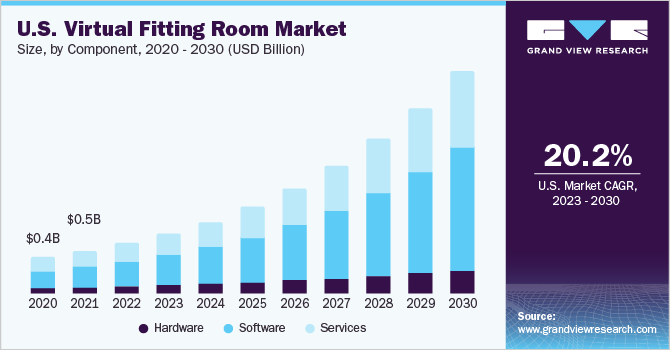Virtual Fitting Room Industry Overview
The global virtual fitting room market size was valued at USD 2.73 billion in 2020 and is expected to expand at a compound annual growth rate (CAGR) of 25.2% from 2021 to 2028. The intervention of Augmented Reality (AR) and Virtual Reality (VR) in virtual fitting room solutions to articulate realistic impressions is expected to majorly fuel the market growth. Furthermore, the rising popularity of the e-commerce sector, growing concerns of online fashion retailers about delivering products that fit appropriately, and the need to cater to the customized demands of customers to survive in an increasingly competitive market are also expected to create promising growth opportunities for the market over the forecast period.
A virtual fitting room, an online replica of an in-store changing space, was introduced in the form of 2D overlays and witnessed a slow start in the fashion retail industry. Nonetheless, the market has observed a robust demand with the emergence of 3D technologies that make use of a mannequin to determine the size of the user. A virtual 3D fitting room represents a collaborative platform between the customer and the fashion brand that attempts to boost customer confidence and minimize the instances where a customer may want to return/exchange a product due to sizing and fitting issues. The ubiquity of intelligent technologies, such as high-quality integrated smartphone cameras, smart mirrors, and high-definition lenses, is expected to drive the adoption of virtual changing room technology over the forecast period.
Gather more insights about the market drivers, restraints and growth of the Global Virtual Fitting Room market
The rise in the number of fashion brands globally has led to numerous sets of options for customers to choose from. This, combined with the decreasing switching costs, has led to fierce competition among retailers. Virtual fitting rooms provide multisensory stimulations to retailers and offer an immersive user experience to consumers to select the appropriate product for purchase. The potential benefits of virtual fitting rooms in attracting online customers to their web and mobile applications are encouraging fashion retailers to invest significantly in deploying the latest virtual dressing room technologies.
One of the key factors limiting the growth prospects of this market is the technology’s inability to detect the entire human body structure at a glance as it identifies only separate body parts. Moreover, inconsistent internet speeds can reduce tracking accuracy in real-time. To overcome this, the key participants are coming up with technology upgrades related to posing estimations with the help of key points in the frame. This may result in the improved accuracy of the technology and help enhance the precision in the appropriate visualization of human structure.

In recent months, the COVID-19 pandemic and the consecutive stay-at-home regulations, as a way of curbing mass gatherings to reduce the spread of the virus, have restructured the virtual fitting room technology’s capabilities. During the initial period, the market for virtual fitting rooms observed a sharp dip as brick and mortar stores across the globe were shut down temporarily and online deliveries of non-essential items were also prohibited. However, the market is slowly recovering and physical stores are opening with necessary precautions. Brick and mortar retailers are increasingly switching to online services as the web and mobile applications are more ideal in the current time since they operate with minimum human interaction. As a result, the utilization of virtual changing rooms is anticipated to witness an increase in the demand for online purchases.
Browse through Grand View Research's Technology Industry Related Reports
Virtual Reality Market - The global virtual reality market size was valued at USD 21.83 billion in 2021 and is expected to expand at a compound annual growth rate (CAGR) of 15.0% from 2022 to 2030.
Digital Transformation Market - The global digital transformation market size was evaluated at USD 608.72 billion in 2021 and is expected to expand at a compound annual growth rate (CAGR) of 23.1% from 2022 to 2030.
Virtual Fitting Room Industry Segmentation
Grand View Research has segmented the global virtual fitting room market on the basis of component, application, end-use, and region:
Virtual Fitting Room Component Outlook (Revenue, USD Billion, 2016 - 2028)
- Hardware
- Software
- Services
Virtual Fitting Room Application Outlook (Revenue, USD Billion, 2016 - 2028)
- Apparel
- Beauty and Cosmetic
- Eyewear
- Footwear
- Others
Virtual Fitting Room End-use Outlook (Revenue, USD Billion, 2016 - 2028)
- Physical Store
- Virtual Store
Virtual Fitting Room Regional Outlook (Revenue, USD Million, 2016 - 2028)
- North America
- Europe
- Asia Pacific
- Latin America
- MEA
Key Companies profiled:
Some prominent players in the global Virtual Fitting Room Industry include
- AstraFit
- Else Corp Srl
- Fision AG
- Fit Analytics
- FXGear Inc.
- Magic Mirror
- MemoMi Labs Inc.
- Metail
- Perfitly
Order a free sample PDF of the Virtual Fitting Room Market Intelligence Study, published by Grand View Research.


No comments:
Post a Comment